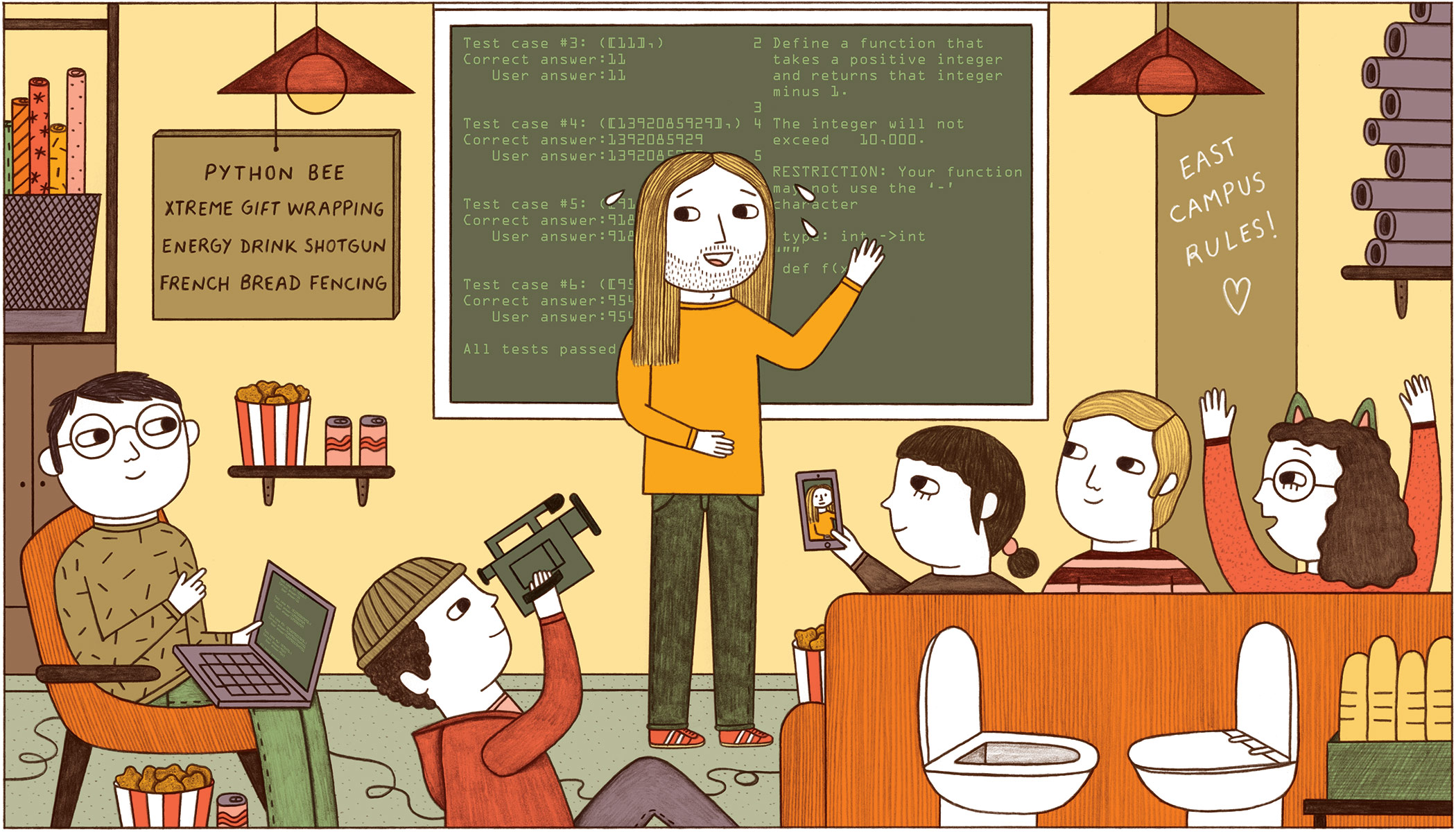
A comfortably large group gathers in the East Campus dormitory’s main lounge, where the day’s schedule for Bad Ideas Weekend spins from the ceiling. Held each year since 2003 during January’s Independent Activities Period (IAP), Bad Ideas actualizes the community’s most impractical ideas without the limits of good judgment, “no skills required.” This evening, the crowd has assembled to attend the nth annual Python Bee (a tradition dating to 2009, but always called the “nth annual”).
Competitors are given tasks to complete using the Python programming language—and they must recite their answers out loud, character by character, as the judge types the work for display on a projector screen behind them. Backspace, control characters, and arrows aren’t allowed, though the current line may be cleared.
“I literally learned Python two weeks ago!” a would-be contestant announces. “Great! That makes you qualified,” replies Brian Chen ’19, who is serving as the judge.
The first problem is straightforward: find the minimum value in a list in less than three minutes. The first contestant calls Python’s min function, to laughter from the audience. For another problem, a contestant finds the median of three integers by taking their sum—to a collective gasp—then subtracting their minimum and maximum, to cheers. Of 11 contestants, five pass round 0.
After that, the game gets harder. Embracing the spirit of Bad Ideas, one rebellious contestant writes code to import and clear the operating system (the operating system and the game both survive). Other challenges, left as an exercise for the reader:
- Given a list containing one integer, retrieve that integer. You may not use brackets.
- Add two integers without using the + character.
- Subtract 1 without using the − character.
- And finally: generate the number 2017 without using digits.
Around the room are ingredients for executing other Bad Ideas: wooden beams, chicken wings, and enough gift wrap for an event at which participants will wrap tables, chairs, and possibly people. Two toilets face each other, procured to make a toilet swing. Other ill-advised activities on the docket include human dog-sledding, hoverboard ice-dancing, speed hair-cutting, opening tape measures beyond their advertised limits, and repeatedly running up and down the stairs of MIT’s Green Building, the tallest building in Cambridge. The seemingly quixotic goal of baking 212 cookies will ultimately be surpassed, producing 4,123 chocolate chip cookies—and proving that sometimes even bad ideas yield good results.
This year’s Python Bee is declared a tie between Aleksejs Popovs ’20 and Yevhenii Diomidov ’18. The prize? Brain-teaser puzzles. This is MIT, after all.
Keep Reading
Most Popular
Large language models can do jaw-dropping things. But nobody knows exactly why.
And that's a problem. Figuring it out is one of the biggest scientific puzzles of our time and a crucial step towards controlling more powerful future models.
The problem with plug-in hybrids? Their drivers.
Plug-in hybrids are often sold as a transition to EVs, but new data from Europe shows we’re still underestimating the emissions they produce.
Google DeepMind’s new generative model makes Super Mario–like games from scratch
Genie learns how to control games by watching hours and hours of video. It could help train next-gen robots too.
How scientists traced a mysterious covid case back to six toilets
When wastewater surveillance turns into a hunt for a single infected individual, the ethics get tricky.
Stay connected
Get the latest updates from
MIT Technology Review
Discover special offers, top stories, upcoming events, and more.